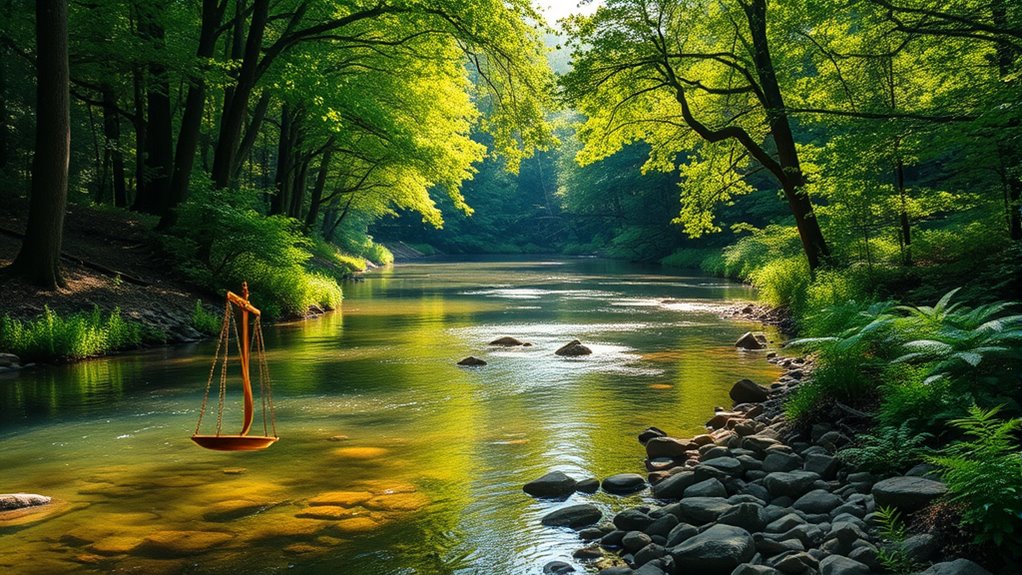Recognizing the legal rights of rivers marks a groundbreaking step in environmental law. It treats water bodies as living entities with intrinsic rights to thrive and be protected, rather than mere resources. This shift allows courts to defend rivers against pollution, damming, and other threats. By establishing ecological sovereignty, these laws empower communities and prioritize ecosystem health. If you want to understand how these legal innovations are shaping a more sustainable future, there’s much more to explore.
Key Takeaways
- Recognizing water bodies as legal entities grants them rights to protection and ecological well-being.
- Water personhood shifts legal focus from resource exploitation to respecting rivers as living communities.
- Countries like New Zealand and Colombia have enacted laws acknowledging rivers’ legal rights, inspiring global change.
- Legal rights for rivers enable courts to intervene against pollution, damming, and ecological harm.
- Embracing water personhood advances ecological sovereignty, promoting sustainable and holistic environmental management.

Have you ever wondered if rivers have legal rights? This question might seem unusual, but it’s central to a growing movement that recognizes water as more than just a resource. Instead, advocates argue for water personhood—an acknowledgment that rivers, lakes, and other bodies of water possess intrinsic rights similar to those of living beings. Water personhood challenges traditional views that see rivers solely as commodities for human use, instead emphasizing their importance within ecological sovereignty. This concept grants rivers the legal standing to be protected and defended, much like individuals or corporations.
By recognizing water personhood, the law begins to treat rivers as entities with rights to exist, flow freely, and maintain their ecological integrity. It shifts the perspective from seeing rivers as property to viewing them as stakeholders with interests that deserve respect. This approach ensures that legal protections are not merely about regulating human activities, but about safeguarding the health of entire ecosystems. When rivers are granted legal rights, courts can intervene to prevent pollution, damming, or other actions that threaten their well-being. It’s a move toward acknowledging that rivers have a form of ecological sovereignty—an inherent authority rooted in their essential role in sustaining life on Earth.
Ecological sovereignty, in this context, means recognizing that natural entities possess an autonomous right to thrive, independent of human economic interests. When a river is granted legal rights, it’s like giving it a voice in legal proceedings, allowing for its interests to be represented and defended. This shift empowers communities and environmental advocates to stand up for rivers in ways that go beyond traditional environmental laws, which often fall short of protecting ecosystems from exploitation. The idea is to treat rivers as living communities, deserving of respect and legal protection, rather than just resources to be used.
This movement toward legal rights for rivers isn’t just theoretical; it’s already happening in some places. Countries like New Zealand and Colombia have recognized the legal personhood of rivers, setting a precedent for others to follow. By doing so, they aim to restore ecological balance and promote sustainable management. Recognizing these legal innovations can inspire broader adoption of ecological sovereignty principles worldwide. Ultimately, embracing water personhood and ecological sovereignty transforms how we view and protect our natural world. It encourages us to see rivers not as commodities, but as essential living entities with their own rights—part of a broader effort to create a more just and sustainable planet.
Frequently Asked Questions
How Are Legal Rights for Rivers Enforced in Court?
When you seek to enforce legal rights for rivers in court, you typically file a lawsuit emphasizing water conservation and ecosystem restoration. You’ll present evidence showing how harm threatens the river’s health and argue that the river has legal standing. Courts then evaluate these claims, granting protections or ordering actions that uphold the river’s rights, ensuring its ecosystem is preserved for future generations.
Can Rivers Sue or Be Sued in Legal Disputes?
Ever wondered if rivers can truly sue or be sued? They don’t have a river personality or legal standing like humans, but legal systems are evolving. Courts recognize rivers as legal entities with rights, allowing them to participate in disputes through guardians or representatives. While they can’t file lawsuits themselves, legal frameworks enable their interests to be protected, giving rivers a voice in court and shifting traditional legal notions.
What Are the Global Differences in River Rights Legislation?
You’ll find that global river rights legislation varies widely, reflecting different cultural significance and indigenous rights. In some countries, like New Zealand and Bolivia, laws recognize rivers as legal entities, honoring their cultural importance and indigenous connections. Meanwhile, other nations prioritize economic uses over ecological or cultural considerations. These differences highlight the ongoing debate about how best to balance environmental protection, cultural values, and legal rights worldwide.
How Do River Rights Impact Local Communities and Industries?
River rights profoundly impact your local community and industries by fostering community engagement and raising economic implications. When rivers gain legal rights, you’re encouraged to involve residents in protecting water sources, which can strengthen community bonds. However, it might also mean stricter regulations that affect industries relying on water, leading to economic shifts. Balancing environmental priorities with economic needs becomes essential as communities adjust to these legal changes.
Are There Any International Laws Protecting River Rights?
You might wonder if international laws protect river rights, especially considering their cultural significance and indigenous recognition. While some treaties and conventions, like the Ramsar Convention, focus on wetlands and water ecosystems, specific protections for river rights are limited. You should know that international efforts increasingly emphasize respecting indigenous connections to rivers, but extensive legal protections remain mainly at the national or local level.
Conclusion
As you stand at the crossroads of environmental justice, remember that granting rivers legal rights is like giving them a voice in their own story. This bold step transforms nature from a silent backdrop into a proactive participant in law. By recognizing rivers as living entities, you become part of a movement that turns the tide toward sustainability. Embrace this new frontier, where the law flows as freely as the rivers it aims to protect.










